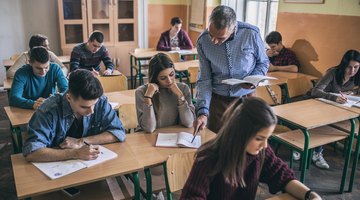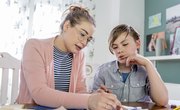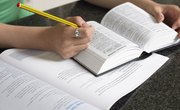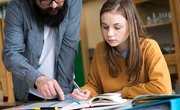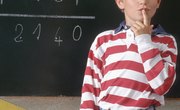Most classrooms consist of students with a range of abilities, from those who for whom academia is second nature to those for whom study and test-taking is a daily struggle. Students come from a wide variety of backgrounds, levels of knowledge and skill sets. However, teachers can create effective learning environments for all students in the classroom.
Accommodate Various Learning Styles
Teaching to multiple learning styles increases the chances of all students understanding the lesson. Present material using pictures and written words to help visual learners, explain material orally for auditory learners, and include a hands-on activity for tactile learners. For instance, a unit for young children teaching colors should have pictures of objects with the different colors, the printed words, a discussion about what the colors are and what objects have that color, and an activity such as creating a collage of items for each color from items cut from magazines.
Assess, Then Adapt
Assessing student achievement is always important, but this is especially true in a diverse classroom. In addition to regular testing, teachers should informally check student understanding and progress through observation, open-ended questions, single-question quizzes and demonstration in order to see what modifications to lessons need to be made. If the classroom includes students with disabilities, implement reasonable accommodations to encourage success. Allow oral tests for students with visual or language disabilities or note takers for those with attention deficit disorder or small motor difficulties.
Same Subject Matter, Different Approaches
Teachers can use a unit concept for all students in the classroom but give students various responsibilities, benchmarks and assessments based on capability. For reading instruction, for instance, students get rewarded based upon how many books they read and comprehend from a level-based list. For a unit about business, students with high math skills could figure sales and income tax, those with poor writing skills could brainstorm marketing ideas and those needing to work on basic math could "run" the cash register.
Peer Learning Aids Students of All Levels
Students can help each other learn in diverse classrooms. Studies indicate group work helps most students learn better. Teachers may place students in groups of differing levels so each group works on a single task or, more appropriately, in heterogeneous groups, mixing understanding and skill levels and assigning each student within the group a task such as the leader, recorder and so on. Even high-level learners gain from such structure. Advanced students will be motivated to study the material more closely so that they can understand it well enough to teach it to their peers.
Related Articles
References
- Yale University: Teaching Students with Different Learning Styles and Levels of Preparation
- University of Washington: MESA Curriculum Addendum: How to Fully Include Students with Disabilities
- Vanderbilt University: Center for Teaching Guides
- Manitoba, Canada: Differentiation in the Multilevel Classroom
- The University of Hawaii System: Ability Differences in the Classroom: Teaching and Learning in Inclusive Classrooms
Writer Bio
Kristie Sweet has been writing professionally since 1982, most recently publishing for various websites on topics like health and wellness, and education. She holds a Master of Arts in English from the University of Northern Colorado.

